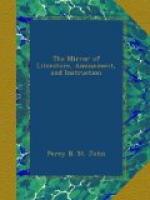Another Correspondent says this luminous “phenomenon may be often seen on a gravel walk upon a moist autumnal evening. It arises from something of a slimy nature emitted by the Scolopendra electrica (one of the animals vulgarly called centipedes), which is luminous. As the animal crawls, it leaves a long train of phosphoric light behind it on the ground, which is often mistaken for the presence of a glow-worm. In all probability, one of these animals had recently crawled over the head of the horse, or rather, might be still crawling there, and the person who saw it unconsciously watched its progress.”
The Short Sunfish
appears to be the name of the “Curious Fish,” described by our indefatigable Correspondent, W.G.C., in The Mirror, vol. xviii. p.168, and quoted by the Editor; he mentioned the occurrence of this fish to Mr. Yarrell, who has furnished a list of references to most of the British authors by whom it has either been described or figured. (See the Magazine, p. 316.)
By the way, Bishop Heber mentions a sun-fish, or, as it is popularly called Devil-fish: it is very large and nearly circular, with vivid colours about it, and it swims by lashing the water with its tail exactly on a level with the surface.
The Char.
The char (Salmo alpinus L.) is found in several of the deep and rocky lakes of England: viz. Coniston in Lancashire, Windermere in Westmoreland, Buttermere and Cromackwater in Cumberland, and, I believe, in Ulswater. My observations are confined to Windermere. Windermere is fed by two streams, which unite at the head of the lake, named the Brathy and the Rothay: the bottom of the former is rocky, and that of the latter sandy. On the first sharp weather that occurs in November, the char makes up the Brathy, in large shoals, for the purpose of spawning, preferring that river to the Rothay, probably owing to the bottom being rocky, and resembling more the bottom of the lake; and it is singular that those fish which ascend the Rothay invariably return and spawn in the Brathy; they remain in this stream, and in the shallow parts of the lake, until the end of March. While spawning, their colour and spots are much darker than when in season; the mouth and fins being of a deep yellow colour; and they are covered with a thick slime at this time. In the water before Brathy Hall, at Clappersgate, hundreds may be seen rubbing and rooting at the bottom, endeavouring to free themselves from the slime, and probably insects that annoy them. Great quantities are caught during the spawning time, by the netters, for potting, and some are sent up fresh for the London market; but those only who have eaten char in summer, on the spot, when they are in season, can tell how superior they are to those eaten in London in the winter. About the beginning of April, when the warm weather comes in, they retire into the deep parts of the lake; where their principal food is the minnow




